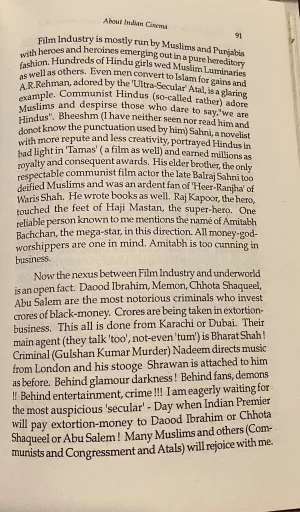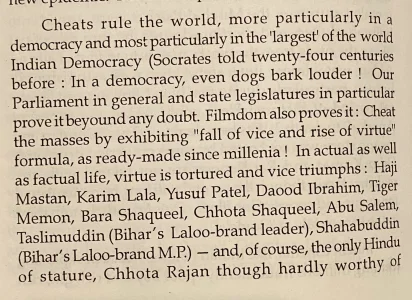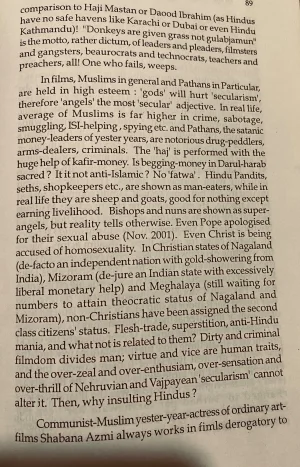You are using an out of date browser. It may not display this or other websites correctly.
You should upgrade or use an alternative browser.
You should upgrade or use an alternative browser.
Fall of Indian Film Industries (1 Viewer)
- Thread starter haldilal
- Start date
More options
Who Replied?- Joined
- Jul 1, 2024
- Messages
- 824
- Likes
- 3,217
even the trailer was quite thrilling and catchy for a court room drama. but struggling at box office againYa'll Nibbiars Kesari Chapter II is good even if the characters and case is actual the story books many fictional plots, despite that is a good film.
View attachment 33294
View attachment 33295
View attachment 33296
Essay is taken from the book of ramprasad misr
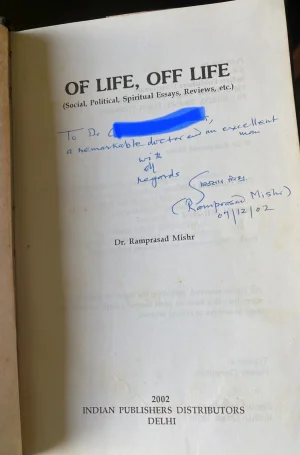
- Joined
- Jun 27, 2024
- Messages
- 2,951
- Likes
- 10,492
They intentionally do that, because western agencies pays them to promote their agenda.
The film is an agenda in the name of freedom of expression and individual rights.
This sums up bollywood, most of them are sell outs to dollars.
- Joined
- Jun 27, 2024
- Messages
- 2,951
- Likes
- 10,492
They intentionally do that, because western agencies pays them to promote their agenda.
The film is an agenda in the name of freedom of expression and individual rights.
This sums up bollywood, most of them are sell outs to dollars.
Almost every movie of Amir is scene to scene copy of western flicks - random mismatch of snippets copied from multiple movies but somehow Amir is the Mr perfectionist.
- Joined
- Jul 1, 2024
- Messages
- 824
- Likes
- 3,217

‘Homebound’ Review: A Moving Friendship Drama Set Against a Politically Fractured India
'Homebound,' Neeraj Ghaywan’s first feature in a decade, is tear-jerking and infuriating.
another movie with same tone. if any of u guys dream of becoming a film writer , just add dalits , muslims, Upper caste evil , BJP bad , hindus , muslims intellectuals , muslims righteous , muslims innocents. to ur movies and u will surely end up in cannes crap fest.
coming to this movie , i could have smelled tone from a mile , with "self proclaimed intellectual varun gober" and jihadi NYT journalist bashrat peer as screen writer, this is another US VISA application project by gaindus of india.
- Joined
- Jun 13, 2025
- Messages
- 457
- Likes
- 1,954
Hindu hate especially general caste hate propaganda by muslimwood .
View: https://x.com/rajanyaofficial/status/1934606649722855775?t=f6acfDQIHYnep3pfw4auDQ&s=19
View: https://x.com/rajanyaofficial/status/1934606669553516659?t=X_e_en9bxH6F3bmJfBQlIw&s=19
View: https://x.com/rajanyaofficial/status/1934606690248511812?t=vkUuklpU4lwOPs1b3h8Dwg&s=19
View: https://x.com/rajanyaofficial/status/1934606719629611164?t=6hYsEhcenjB6iPqvh-3BnA&s=19
View: https://x.com/rajanyaofficial/status/1934606737736384644?t=SV3IVzOm1VtUUXWGfGCaDw&s=19
View: https://x.com/rajanyaofficial/status/1934606649722855775?t=f6acfDQIHYnep3pfw4auDQ&s=19
View: https://x.com/rajanyaofficial/status/1934606669553516659?t=X_e_en9bxH6F3bmJfBQlIw&s=19
View: https://x.com/rajanyaofficial/status/1934606690248511812?t=vkUuklpU4lwOPs1b3h8Dwg&s=19
View: https://x.com/rajanyaofficial/status/1934606719629611164?t=6hYsEhcenjB6iPqvh-3BnA&s=19
View: https://x.com/rajanyaofficial/status/1934606737736384644?t=SV3IVzOm1VtUUXWGfGCaDw&s=19
- Joined
- Jun 13, 2025
- Messages
- 457
- Likes
- 1,954
- Joined
- Jun 13, 2025
- Messages
- 457
- Likes
- 1,954
India must ban hollywood and non indian movies in india.
View: https://x.com/RoseTint4/status/1935316544793215017?t=jnojf-YRIs-B_9YCZCfofg&s=19
View: https://x.com/RoseTint4/status/1935316544793215017?t=jnojf-YRIs-B_9YCZCfofg&s=19
- Joined
- Sep 29, 2024
- Messages
- 5,372
- Likes
- 29,268
View: https://youtu.be/dK1W-AViQ-M?t=51
At 51secs it says ((( This Independence Day )))
Film is releasing on August 14th.
The ISI could tell it's nautanki slaves to be less on the nose you know

Origins of the Islamisation of Hindi Cinema
IntroductionIn Hindi cinema music, Rama, Krishna, or any Sanatana reference or even chaste Hindi, are conspicuous by their absence. ’Alla’, Maula’, and ‘Ali’ pr
Origins of the Islamisation of Hindi Cinema
An essay on how the foundation for the Islamisation of Hindi cinema was laid as early as the 1930s beginning with the film, "Alam Ara."
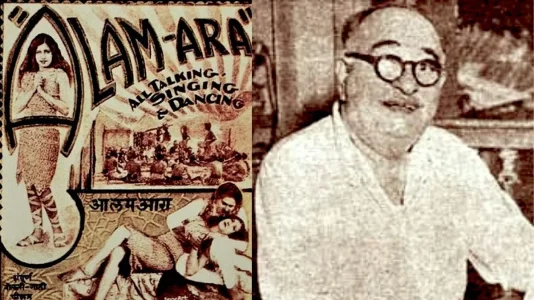
Introduction
In Hindi cinema music, Rama, Krishna, or any Sanatana reference or even chaste Hindi, are conspicuous by their absence. ’Alla’, Maula’, and ‘Ali’ proliferate songs. Urdu/Hindustani has completely taken over.
Hindi songs are rare - they’re at best Hindustani (a mix of Hindi & Urdu). Where are songs like hari bhari vasundhara me neela neela ye gagan sung by Mukesh (Boond Jo Ban Gaye Moti, 1967. Producer - V Shantaram; Music - Satish Bhatia, Lyrics - Bharat Vyas).
It is often seen as the ‘fascination’[1]of the Hindi film world that has been partial towards Mughal themes, but I think it has become a culture in and by itself given the political history of this supposedly artistic universe.
This is a fact.
The Bombay Ecosystem
The emergent ecosystem, especially, in Bombay in the ‘30s was all about party politics and economics, and as a corollary, about art consumption. This is the broad theme of this essay.
Popularity of songs depends on the ecosystem which generates and receives it. An insular audience is a utopia. The tastes of audiences are developed and ‘cultivated’ (to borrow from espionage terminology). The popularity and most importantly, the appeal of a song will depend on the distribution of narratives aimed at developing tastes. Sales of strategic narratives grows in direct proportion to the extent an audience is influenced. In that, the popularity of a film with a certain ideological position is a good measure of how much that ideology has been entrenched.
So, if the distribution of a film is controlled by vested interests then its visibility will also be controlled. For example, ghazals will outnumber say, geets as has clearly happened. Exclusive eulogy of these ghazals by the said ecosystem elements on all forums and a complete neglect of geets is nothing but the planned cultivation of taste and of opinion.
Observations
To my mind, the seeds of Islamisation of Hindi film songs were, inadvertently or otherwise, sowed in our first talkie - Alam Ara. The name itself is an indirect Quranic name for girls.[1] Yet, it may also be seen as an attempt to bring about social change, especially in the Muslim community vis a vis women.
Alam Ara, exactly 91 years and 32 days from today, was made by the Pune-born Ardeshir Irani who grew up in Mumbai. He had set the ball rolling for singers to sing and actors to lip-sync and talk. In effect, the Indian film industry got its voice thanks to this Irani whose father had left his motherland Iran, due to religious persecution and settled in Pune.
While Dadasaheb Phalke’s Raja Harishchandra (May 1913) is considered to be the first Indian movie and was based on an ancient Sanatana theme, Alam Ara (March 1931), the first Indian talkie was based on a Parsee play. Both were phenomenal successes. But in Alam Ara, barring one, darasa bina tarse hain naina most of the songs were Urdu ghazals.
The decision to have a Parsee theme and Muslim actors and music may have something to do with a complex mix of the buying power of the Bombay residents in 1930s and the social message to the Muslims who were better off than the Hindus. The distribution of wealth among the population of Bombay was discernibly unequal and surprisingly, categorizable by the faith they followed.
According to the 1931 Census of India, Hindus were the worst off, followed by Muslims in terms of the kind of houses they lived in. The Parsees were the best placed followed by Jains. But by 1931, the percentage of Hindus living in Bombay had considerably declined and that of that of Muslims had increased considerably when compared to the 1921 Census. I also see a commercial sense in making a film that caters to Parsees and Muslims under such circumstances
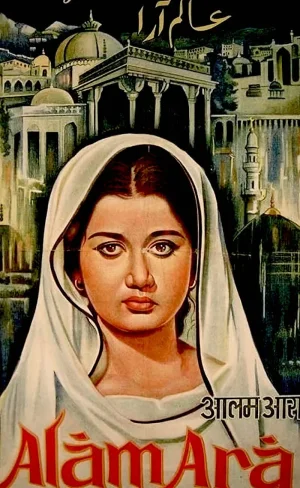
However, there is no denying that Alam Ara paved the way for music and dialogue on screen, in India. It was the first to use source music and sound by placing large microphones inside the costumes of actors. So, diegetic sound (that which emanates from the world of story) was first recorded in India thanks to this 124-minute film. Firozeshah M. Mistry and B. Irani were the music directors. But the film did not have a single non-Muslim singer.
Unfortunately, analysis of the music of this film is at present impossible as we do not have a copy of this film. It is not available even in the National Film Archives of India (NFAI), Pune after a fire in 2003 allegedly destroyed many films including Alam Ara. This was denied by NFAI.
The first song (in Urdu) De De Khuda Ke Naam sung by Wazir Mohammed Khan, has clear Islamic exhortations prima facie, and rather dull lyrics:
De de kuda ke naam pe pyaare,
taakat ho gar dene ki.
kuch chaahe agar, to mang le mujhse
himmat ho gar lene ki.
Give in the name of God my dear,
if you have the guts to give.
if you need anything, ask me
if you have the courage to accept it.
Like most other songs in Alam Ara, the one sung by Zubeida is a ghazal and probably based on the rare Raga Kankan or maybe the popular Mishra Khamaj, the latter being more likely.
India’s first playback song mere ghar mohan ayo arrived in 1935 in Dhoop Chhaon when R C Boral and Pankaj Mallik did the scores. The singers were Harimati, Supra Sarkar, Parul Ghosh and K.C. Dey. This is a very difficult song and must have been very impressive on screen too, but our sensibilities have changed so much that we cannot enjoy it anymore.
The blind singing sensation of the mid 1930s was K.C. Dey (the celebrated singer Manna De’s uncle). He acted and sang with a rather powerful voice which even Manna De has confessed he cannot replicate. Interestingly, K.C. Dey never ever sang for any other actor. Barring one ghazal type of song, all other eight songs are devotional or philosophical.
There were a number of so-called ‘mythological’ films and there were also movies which reflected a non-Muslim and non-Communist worldview. But these were few and far between and were gradually supplanted by critiques of the Sanatana worldview by the Muslim dominated ‘new age’ of cinema, whose strong messaging was done through music.
Connecting the Dots from the Past
Realising the power of this new medium, the following writers’ groups were formed in the 1930s, again dominated by Muslims, but clearly masquerading as the Left:• The Indian Progressive Writers' Association: London,1935.
• The Progressive Writers' Association: Kolkata, 1936.
• The All India Writers’ Association: Lucknow, 1936 led by Syed Sajjad Zahir and Ahmed Ali at the Rifa-e-Aam Club, who invited Syed Fakhruddin Balley to join. Writers and poets like Hameed Akhtar, Faiz Ahmad Faiz, Ahmad Nadeem Qasmi, Saadat Hasan Manto and Ismat Chughtai joined.
• The All Pakistan Progressive Writers' Association: Pakistan, 1947.
It must be noted that the most influential filmmaker, critic, and script writer of that time, Khwaja Ahmed Abbas, was part of the PWA and Indian People’s Theater Association. It is clear why Hindi movies were used as a powerful tool to systematically dismantle the Sanatana worldview. Each Sanatana value was deliberately misinterpreted by these Leftists. Here is Doraiswamy’s (2018) eulogy of K.A. Abbas and the Left:
The Nehruvian vision shaped the ideological horizon of the '50s, and given the presence of a Marxist line in Nehru’s thinking, its coming together with the IPTA line did make the ideological scales weigh in favour of a Left orientation in the narratives of the time. Directors, scriptwriters, song-writers, composers, actors all left their progressive imprints in the films produced during those times. Among the well-known actors who had an allegiance to the IPTA were Balraj Sahni, A.K. Hangal and Utpal Dutt; well-known music directors included Anil Biswas, Salil Choudhury, Hemant Kumar and Ravi Shankar; song writers Sahir Ludhianvi, Majrooh Sultanpuri, Prem Dhawan, Shailendra, Kaifi Azmi were associated with the PWA and IPTA; scriptwriters K.A. Abbas (also a director) and V.P. Sathe were IPTA members; directors Bimal Roy, Shombhu Mitra, Mohan Sehgal were closely involved with the IPTA, as were the dance directors Uday Shankar and Prem Dhawan (who choreographed songs in Do Bigha Zameen (Two Thirds of an Acre of Land/1953) and Naya Daur (New Age/1957).
Conclusion
It is very clear from the above facts that a strong plinth was laid down for Hindi films to grow the way they have grown subsequently. Today, it is the edifice which is held by this very plinth. It has nothing Hindu about it, barring some songs which are based on Ragas. In the strongest medium today - cinema, lyrics, pronunciation, vocal timbre, story plots, background music, sound effects, etc. are all far, far away from what they should have been, had we held on to our Dharmic roots. As audience and as an artistic community, our timeless traditional value systems have been deeply compromised.Revisiting the Radio Station in Rang De Basanti: A Case Study in Bollywood Communist Propaganda
A comprehensive critique of the 2006 Hindi film, "Rang De Basanti" as a vehicle of Communist propagandaPreface
Rang de Basanti is quite an impressive movie. Of explicit communist propaganda shot on a lavish budget. Its director, co-writer and co-screenwriter Rakeysh Omprakash Mehra suffered from none of the prostrate handicaps of his counterparts just a generation ago who wanted to peddle communist propaganda in commercial cinema. That gap was filled back then by shrouded bigots like Javed Akhtar who has since shed his clothes and emerged naked as a full blown Islamic fanatic. In those days, all communist propaganda was essentially constrained by a largely innocent, devout, superstitious and “backward” Hindu audience whose uncorrupted innocence was their unerring spiritual guide that made them zoom right in on the truth: avoid all “art” films. This audience patronised, heavily and repeatedly, patronised films that showed a wet and voluptuous rain-soaked Smita Patil’s seductive slithering on an empty vegetable cart over trying to catch a fleeting glimpse of her bare, sweaty back in a lighting that was neither late evening nor night. This deserved stigma attached to “art” films is a permanent scar that the Leftists still can’t shake off. That’s the reason they have coined an innocuous substitute for it—“parallel cinema.” “Art” films also earned nationwide apathy and contempt for a more
commonplace reason: no mainstream producer trusted these communist hawkers with his money.
But the India, of the new millennium was a vastly changed socio-cultural landscape. What was known as communism was now a billion splinters of a fifteen year-old ideological wreckage.
In this India, the poor and the lower-middle class now aspired to wealth, not revolution. However, the same interim had also churned out the Liberalisation Generation which today has become the parents of Incurables and baby Incurables. This generation has absolutely no knowledge let alone the lived experience of life in a quasi-communist dictatorship. Even the notion of standing for an hour in queue to deposit a ₹ 10 cheque and cringing before the bank clerk, a mini-despot in his 3 x 3 Cubicle Empire, sounds unbelievable to this Liberalisation generation. A new hunting ground.
Provoking mass fury is relatively easy in a nation of government-enforced shortages and the frustration, jealousy and hopelessness that this environment engenders. However, in a country which repeatedly throws up rags-to-riches success stories, provoking mass anger is seen as the first sign of a lazy loser. The only way to inject communist poison in such a landscape is to alter specific areas of perception in the psyche of this very aspirational class. Perception building is the embryo that nurtures propaganda well until adulthood, a tactic the communists have perfected for a century.
https://www.dharmadispatch.in/podca...r-history-of-indian-communism-in-half-an-hour
In the urban-middle-class India of the new millennium, political corruption was still a glaring daily reality. Economic liberalisation which was done largely under the duress of desperate national circumstances eventually grew up as a deformed teenager. The other side of this was that petty political pickpocketing eventually transformed into national plunder as a percentage of the GDP. But that plunder was still in the nascent stage because the new UPA government was still figuring out schemes to put the flood of entrepreneurial and economic energy undammed by both P.V. Narasimha Rao and Atal Bihari Vajpayee back in the narrow-necked bottle which could only be uncorked by political patronage. The GDP loot that followed hadn’t begun yet but political corruption as a burning urban issue was still dominant.
Which is the ostensible premise of Rang de Basanti: a courageous fight by a bunch of aimless Delhi-based youth who find purpose, fulfilment…and death in their fight against this corrupt political establishment. This is a plot old as civilisation itself and as enduring if told well. Rang de Basanti does tell it well except that it is communist propaganda masquerading as said courageous fight.
Propaganda From Scene Zero
Indeed, the propaganda begins almost immediately as the opening credits begin rolling. With the iconic freedom fighter Bhagat Singh telling the British jailer, “one revolutionary is getting acquainted with another,” before closing Lenin’s biography and then marching to the gallows with a proud, brave smile on his lips. Expectedly consistent with the trope of secularism, we are also shown Ram Prasad Bismil chanting verses from the Karma Yoga chapter of the Bhagavad Gita. The symbolism that begins from here is generously, relentlessly spray-painted throughout the movie as we shall see.
Indeed, the communists have benefitted from secularism more than Nehru’s dynasty; the dividends they have reaped are far more diabolical and long-lasting than the mere electoral victories gained by the Congress. If you find this hard to believe, think about why Rahul Gandhi had to contest from Waynad and the humiliation he had to undergo at the hands of the Communists in exchange.
Cut to the present.
We’re shown the character of Sue, the granddaughter of Mr. McKinley, the same British jail official who plugged the plug on Bhagat Singh and Bismil. He is deeply moved by their unyielding courage and unflinching patriotism which makes them embrace death as a friend, with a smile. A devout Christian, he repeatedly asks forgiveness from Jesus. Sue who reads his experiences in a diary which he has left behind is similarly moved and wants to make a movie on these great revolutionary freedom fighters. She is shown as a journalist working for a British news channel. Its name is revealed in the large signage behind the reception desk for about three minutes: World Vision.
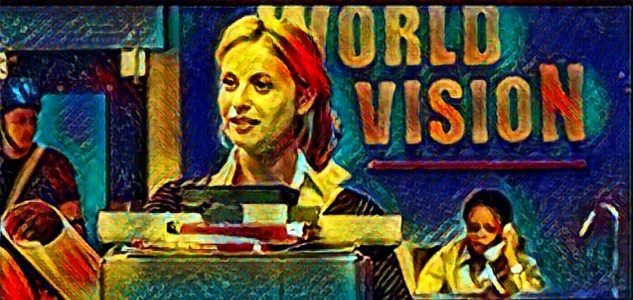
And that’s how propaganda is done. Throughout the movie. At strategic plot points. Through one-liners, props, backdrops, dressing, body language…sometimes subtle, sometimes direct.
A British filmmaker who comes to India to make a movie about Indian revolutionaries is quite telling by itself. The former coloniser returning once more to redeem the former subject race which has forgotten its own heroes. A racist colonial echo somewhere: bloody hell! look what a mess these bloody Indians have created for themselves after we left! This archetype is immediately vindicated when Siddharth who plays Bhagat Singh tells a shocked Sue who witnesses public bribery, “ welcome to India.” It is a different matter that the cop who is bribed is doing the duty of trying to arrest drunken and drugged out louts for illegal behaviour in public. Somehow, the point is buried under the propaganda that depicts Siddharth as a symbol of the frustrated and hopeless urban Indian youth.
And so, Sue eventually finds the perfect guys to cast as revolutionaries in her film: DJ (Aamir Khan) as Chandrashekhar Azad, Karan (Siddharth) as Bhagat Singh, Aslam (Kunal Kapoor) as Ashfaqullah Khan, and Sukh Ram (Sharman Joshi) as Shivram Rajguru. Four jobless louts in the prime of their youth. Plus a fifth one we shall soon get to. The five gradually undergo a profound transformation as they read Sue’s script and begin practicing their lines. The process of this transformation forms the crux of the film. It is also a dramatic device used for effective propaganda.
At the outset, Sue’s filmmaking endeavor is straight off the hot communist press – of using literature, art, drama and cinema as propaganda vehicles to stoke revolution and overthrow constitutionally elected governments. The full implication of this will chill us when we recall the fact that throughout its blood-soaked history, not a single communist regime has come to power through free and fair elections. From Russia to the entire (former) Eastern European bloc to Cuba, communists have literally seized power through prolific violence against their own countrymen and once in power, have committed industrial scale genocide, again, against their own countrymen. Remember this when—and if—you watch Rang de Basanti.
Celebrating JNU
The majority of scenes showing Sue’s interactions with the four young wastrels are akin to the deepest revolutionary sexual fantasies coming alive on screen. The setting of their university campus at India Habitat Centre, another expensive lounge built by, for and of Leftist taxpayer-moochers is also symbolic…actually let me correct that…it is realistic and highly appropriate. The movie is shot in real life at India Habitat Centre. What it really shows is the JNU campus. And Rakeysh Omprakash Mehra simply can’t get enough of it. The camera captures almost every cranny and crevice, complete with a run-down local cafeteria…Rang de Basanti’s own version of the infamous JNU Ganga dhaba, the perennial hangout of budding and advanced communist nation-wreckers spouting Marxism over chai, cigarettes and charas. The voiceless undertone of the whole environment screams at us: revolution is not only heroic, it is sexy. And celebrated. Every illegal activity is a celebration: spray-painting campus walls with ugly communist graffiti at night, binge drinking and smoking marijuana in public, vandalism, and indulging in behaviour that endangers lives. And the rival student leader who objects to all this is shown as…no surprise…a regressive, violent Hindutva activist who wants to take away this “freedom.”
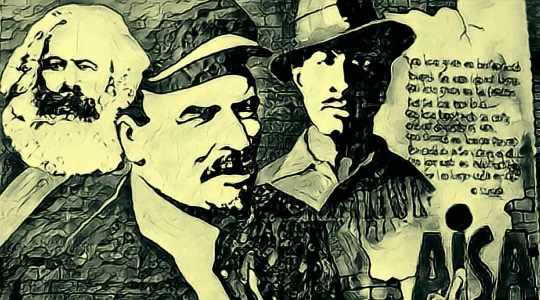
This leader, Lakshman Pandey, is the aforementioned fifth character who plays Ramprasad Bismil in Sue’s film. But Pandey cannot play Bismil as long as he is a Hindutva militant. He has to thoroughly reform himself before he can be transformed into a communist porn star. A process that Rang de Basanti uncurtains quite skilfully.
Overall, it’s an eclectic mix of Sue’s Five.
Examining Sue's Five
First we have Aslam, the stereotypical educated, decent, and urbane Muslim dolled up like a drug-addled JNU-cousin of the communist monster and Fidel Castro’s chief executioner, Ernesto Guevara De La Serna, popularly known as Che Guevara. For good measure, Aslam’s father is the archetypal Dara Hua Musalman, and Aslam’s brother is the archetypal Hindu-hating, hardcore Muslim fanatic precisely because the dad is a Dara Hua Musalman.
Then we’re introduced to Karan, the frustrated brat of a filthy rich—and by definition highly corrupt—businessman whose business is to fix shady defence deals that results in the death of an Indian Airforce pilot, who not coincidentally happens to be the close friend of Sue’s Five. He can’t be Sue’s Sixth because there’s no part for him in her film.
While each of these JNU losers have their own individual moments of transformation as they read Sue’s script, it all comes together and turns into a collective moment of decisive revolutionary action when they hear the news of the said pilot friend’s tragic death. The friend, Flight Lieutenant Ajay Rathod (played by Madhavan) is killed when the MIG aircraft he was flying crashes because of high-level corruption in defence procurement. The corruption is directly linked to the Indian defence minister himself. And in that precise moment of embarking upon the revolutionary action, they actually become the current incarnations of Chandrashekhar Azad, Bhagat Singh, Shivram Rajguru, et al. The sepia tone of the heroic past literally merges into an explosion of stunning colours of the digital, unjust present. It is at this point that Rakeysh Omprakash Mehra’s celluloid communist propaganda acquires the wings of a vengeful falcon and soars on a radical flight and finally swoops down to descend on the inevitable climax.
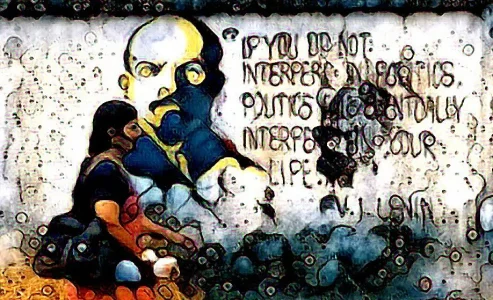
You name the Congress-Communist slur hurled against the BJP, Rang de Basanti serves it up with special relish. Let’s look at a few major slurs. The corrupt defence deals, its long-standing image as a Brahmin-Bania party, its alleged hatred against Muslims, its militant Hindutva ideology, its regressive attitude towards “western culture…” Rang de Basanti wages war against them all.
It’s not a coincidence that the defence minister of India in the period in which Rang de Basanti is set has the Brahmin surname, “Shastri.” But just to be clear, this Shastri bears a not-so-slight resemblance to former defence minister, George Fernandes who was forced to resign owing to the brothel journalism of Tehelka. It is also not a coincidence that the selfsame Tehelka plastered a laudatory visual of Rang de Basanti on the cover page of its second anniversary issue published in 2006, the same year the movie was released. Try and beat this ecosystem if you can.
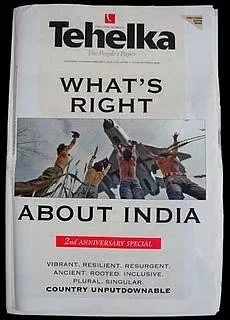
Quite obviously, the Dara Hua Musalman dad played by Om Puri has to mouth these mandatory lines: “Yeh hum logon ke liye bahut boora waqt hai” (these are really bad times for us Muslims). That was a line in a fictional movie. As a great believer in the cyclical nature of Time, I’ll say that it was only a matter of time before fiction became reality. The selfsame Aamir Khan who played Chandrashekhar Azad in Rang de Basanti decided to shed his clothes in 2015 and revealed his utter absence of gratitude to India by declaring that he felt unsafe as a Muslim here. And added an extra layer of fat to his ingratitude by grovelling before PM Modi instead of doing the heroic thing by emigrating out of India. Actors imitating their movies; the unreal is real and the real is diabolical.
But it is in the depiction and treatment of Hindutva and the BJP as a political party with a specific ideology that Rang de Basanti really bares its poisoned fangs. Lakshman Pandey, before discovering his inner Ramprasad Bismil is the metonym of militant and regressive Hindutva. His surname, Pandey, is indicative of a dominant north Indian “caste.” His violent boorishness and lack of manners is unmistakably rooted in his rustic Hindu cultural background, and is therefore a misfit in that closeted communist drug-adda, a den within the JNU den. But it is Sue who awakens his inner Ramprasad Bismil as he’s incapable of even possessing such a faculty. Sue, the large-hearted Sue, the 21st Century carrier of the 19th-century, weighty White Man’s Burden of properly re-civilising this native Hindoo…an unfinished task. Sue discharges this onerous duty by “healing” (the latest Leftist weasel word) the hostility between Pandey and the four other jobless slobs.
But Pandey still has a long way before becoming fully civilised. That occurs with the penultimate step of his violent disillusionment with his Hindu-culture-championing, nationalist party in power at the Centre. When he confronts his mentor in the party who is shown to be close to the corrupt defence minister about the MIG crash, the mentor has him beaten up. Right there flows the suggestion: this is how the BJP treats its most loyal Karyakartas. Oh, the mentor also bears an indistinct resemblance to the then Gujarat Chief Minister. Torn, wounded and bloody, Pandey is later offered weed by the opulent drug addict, the filthy rich Karan seated on the steps of a hospital. It’s a real heady homoerotic moment, the chocolate boy Siddharth and the rugged rustic Atul Kulkarni sharing a drag. But weed only brings temporary relief to Pandey who has to take that decisive ultimate step before he is fully cured of the purgatory hell of Hindutva. That ultimate step is his apology to Aslam. Lakshman Pandey is now thoroughly civilised, i.e. secular. A new communist porn star is born.
Communist Propaganda is Depravity
It’s truly remarkable, the planes of depravity on which the sick propaganda operates. Lakshman Pandey is shown as basically a good guy in the wrong camp. But before he can fully “belong” to the…errrr… “right”, i.e. left camp, he must consciously, explicitly shed and disown the last atom of his previous life. Akin to a converted Hindu eating beef and getting circumcised as a sort of final mark of conversion. Akin to Stalin’s show trials where the innocent “criminal” is made to publicly confess heinous crimes he didn’t commit. This is cinematic subterfuge at its degenerate worst.
But Pandey’s disillusionment with his ideology and party has actually occurred much earlier when he sits on the protest against the unnecessary, horrible death of Ajay Rathod, the guy who has worn the noble IAF uniform to protect and serve his nation. The same nation headed by the government of a nationalist party engaged in sleazy defence deals. Which is a good place to segue to that other favourite communist-secular trope: of the BJP as a party of fat cat, unscrupulous businessmen.
We’re shown the character of Sue, the granddaughter of Mr. McKinley, the same British jail official who plugged the plug on Bhagat Singh and Bismil. He is deeply moved by their unyielding courage and unflinching patriotism which makes them embrace death as a friend, with a smile. A devout Christian, he repeatedly asks forgiveness from Jesus. Sue who reads his experiences in a diary which he has left behind is similarly moved and wants to make a movie on these great revolutionary freedom fighters. She is shown as a journalist working for a British news channel. Its name is revealed in the large signage behind the reception desk for about three minutes: World Vision.

And that’s how propaganda is done. Throughout the movie. At strategic plot points. Through one-liners, props, backdrops, dressing, body language…sometimes subtle, sometimes direct.
A British filmmaker who comes to India to make a movie about Indian revolutionaries is quite telling by itself. The former coloniser returning once more to redeem the former subject race which has forgotten its own heroes. A racist colonial echo somewhere: bloody hell! look what a mess these bloody Indians have created for themselves after we left! This archetype is immediately vindicated when Siddharth who plays Bhagat Singh tells a shocked Sue who witnesses public bribery, “ welcome to India.” It is a different matter that the cop who is bribed is doing the duty of trying to arrest drunken and drugged out louts for illegal behaviour in public. Somehow, the point is buried under the propaganda that depicts Siddharth as a symbol of the frustrated and hopeless urban Indian youth.
And so, Sue eventually finds the perfect guys to cast as revolutionaries in her film: DJ (Aamir Khan) as Chandrashekhar Azad, Karan (Siddharth) as Bhagat Singh, Aslam (Kunal Kapoor) as Ashfaqullah Khan, and Sukh Ram (Sharman Joshi) as Shivram Rajguru. Four jobless louts in the prime of their youth. Plus a fifth one we shall soon get to. The five gradually undergo a profound transformation as they read Sue’s script and begin practicing their lines. The process of this transformation forms the crux of the film. It is also a dramatic device used for effective propaganda.
At the outset, Sue’s filmmaking endeavor is straight off the hot communist press – of using literature, art, drama and cinema as propaganda vehicles to stoke revolution and overthrow constitutionally elected governments. The full implication of this will chill us when we recall the fact that throughout its blood-soaked history, not a single communist regime has come to power through free and fair elections. From Russia to the entire (former) Eastern European bloc to Cuba, communists have literally seized power through prolific violence against their own countrymen and once in power, have committed industrial scale genocide, again, against their own countrymen. Remember this when—and if—you watch Rang de Basanti.
Celebrating JNU
The majority of scenes showing Sue’s interactions with the four young wastrels are akin to the deepest revolutionary sexual fantasies coming alive on screen. The setting of their university campus at India Habitat Centre, another expensive lounge built by, for and of Leftist taxpayer-moochers is also symbolic…actually let me correct that…it is realistic and highly appropriate. The movie is shot in real life at India Habitat Centre. What it really shows is the JNU campus. And Rakeysh Omprakash Mehra simply can’t get enough of it. The camera captures almost every cranny and crevice, complete with a run-down local cafeteria…Rang de Basanti’s own version of the infamous JNU Ganga dhaba, the perennial hangout of budding and advanced communist nation-wreckers spouting Marxism over chai, cigarettes and charas. The voiceless undertone of the whole environment screams at us: revolution is not only heroic, it is sexy. And celebrated. Every illegal activity is a celebration: spray-painting campus walls with ugly communist graffiti at night, binge drinking and smoking marijuana in public, vandalism, and indulging in behaviour that endangers lives. And the rival student leader who objects to all this is shown as…no surprise…a regressive, violent Hindutva activist who wants to take away this “freedom.”

This leader, Lakshman Pandey, is the aforementioned fifth character who plays Ramprasad Bismil in Sue’s film. But Pandey cannot play Bismil as long as he is a Hindutva militant. He has to thoroughly reform himself before he can be transformed into a communist porn star. A process that Rang de Basanti uncurtains quite skilfully.
Overall, it’s an eclectic mix of Sue’s Five.
Examining Sue's Five
First we have Aslam, the stereotypical educated, decent, and urbane Muslim dolled up like a drug-addled JNU-cousin of the communist monster and Fidel Castro’s chief executioner, Ernesto Guevara De La Serna, popularly known as Che Guevara. For good measure, Aslam’s father is the archetypal Dara Hua Musalman, and Aslam’s brother is the archetypal Hindu-hating, hardcore Muslim fanatic precisely because the dad is a Dara Hua Musalman.
Then we’re introduced to Karan, the frustrated brat of a filthy rich—and by definition highly corrupt—businessman whose business is to fix shady defence deals that results in the death of an Indian Airforce pilot, who not coincidentally happens to be the close friend of Sue’s Five. He can’t be Sue’s Sixth because there’s no part for him in her film.
While each of these JNU losers have their own individual moments of transformation as they read Sue’s script, it all comes together and turns into a collective moment of decisive revolutionary action when they hear the news of the said pilot friend’s tragic death. The friend, Flight Lieutenant Ajay Rathod (played by Madhavan) is killed when the MIG aircraft he was flying crashes because of high-level corruption in defence procurement. The corruption is directly linked to the Indian defence minister himself. And in that precise moment of embarking upon the revolutionary action, they actually become the current incarnations of Chandrashekhar Azad, Bhagat Singh, Shivram Rajguru, et al. The sepia tone of the heroic past literally merges into an explosion of stunning colours of the digital, unjust present. It is at this point that Rakeysh Omprakash Mehra’s celluloid communist propaganda acquires the wings of a vengeful falcon and soars on a radical flight and finally swoops down to descend on the inevitable climax.
Indian Freedom Fighters as Lenin's Revolutionaries
Rang de Basanti’s blockbuster commercial success would have been impossible if it hadn’t been sexed up with a cherry-picked and twisted narrative of these genuinely revolutionary heroes of our freedom struggle. Although Bhagat Singh was a declared admirer of Lenin, his admiration was based entirely on the laudatory hagiographies of the psychotic maniac Lenin, which had flooded markets worldwide. Besides, Bhagat Singh advocated armed struggle to overthrow an oppressive foreign power, the colonial British. Who did Lenin overthrow in a murderous coup? Whose blood he spill so copiously? That of his own countrymen. Contrast the yawning canyon separating the fundamental character of Bhagat Singh and Vladimir Lenin. The former, a mere boy when he died, was innately noble, virtuous, compassionate, patriotic and truly heroic. One has to be congenitally depraved at the level of the soul in order to be a communist. Now imagine the scale of depravity necessary to be Lenin. But then appropriating truly great heroes is another feat of diabolism that the Leftists have perfected. For the longest time, West Bengal communists tried to appropriate Swami Vivekananda as a communist but failed miserably.
Vajpayee's Government = Colonial British Rule
The parallel in Rang de Basanti is unmistakable: there is no difference between the constitutionally elected government of independent India and colonial British rule. Therefore, all methods and tactics to overthrow it are not only valid but are feats of freedom struggle. But the Indian government in Rang de Basanti is not just any government. Which is where the other face of the coin is revealed. Rang de Basanti is a movie that specifically targets the BJP-led Government, the NDA 1.0.You name the Congress-Communist slur hurled against the BJP, Rang de Basanti serves it up with special relish. Let’s look at a few major slurs. The corrupt defence deals, its long-standing image as a Brahmin-Bania party, its alleged hatred against Muslims, its militant Hindutva ideology, its regressive attitude towards “western culture…” Rang de Basanti wages war against them all.
It’s not a coincidence that the defence minister of India in the period in which Rang de Basanti is set has the Brahmin surname, “Shastri.” But just to be clear, this Shastri bears a not-so-slight resemblance to former defence minister, George Fernandes who was forced to resign owing to the brothel journalism of Tehelka. It is also not a coincidence that the selfsame Tehelka plastered a laudatory visual of Rang de Basanti on the cover page of its second anniversary issue published in 2006, the same year the movie was released. Try and beat this ecosystem if you can.

Quite obviously, the Dara Hua Musalman dad played by Om Puri has to mouth these mandatory lines: “Yeh hum logon ke liye bahut boora waqt hai” (these are really bad times for us Muslims). That was a line in a fictional movie. As a great believer in the cyclical nature of Time, I’ll say that it was only a matter of time before fiction became reality. The selfsame Aamir Khan who played Chandrashekhar Azad in Rang de Basanti decided to shed his clothes in 2015 and revealed his utter absence of gratitude to India by declaring that he felt unsafe as a Muslim here. And added an extra layer of fat to his ingratitude by grovelling before PM Modi instead of doing the heroic thing by emigrating out of India. Actors imitating their movies; the unreal is real and the real is diabolical.
But it is in the depiction and treatment of Hindutva and the BJP as a political party with a specific ideology that Rang de Basanti really bares its poisoned fangs. Lakshman Pandey, before discovering his inner Ramprasad Bismil is the metonym of militant and regressive Hindutva. His surname, Pandey, is indicative of a dominant north Indian “caste.” His violent boorishness and lack of manners is unmistakably rooted in his rustic Hindu cultural background, and is therefore a misfit in that closeted communist drug-adda, a den within the JNU den. But it is Sue who awakens his inner Ramprasad Bismil as he’s incapable of even possessing such a faculty. Sue, the large-hearted Sue, the 21st Century carrier of the 19th-century, weighty White Man’s Burden of properly re-civilising this native Hindoo…an unfinished task. Sue discharges this onerous duty by “healing” (the latest Leftist weasel word) the hostility between Pandey and the four other jobless slobs.
But Pandey still has a long way before becoming fully civilised. That occurs with the penultimate step of his violent disillusionment with his Hindu-culture-championing, nationalist party in power at the Centre. When he confronts his mentor in the party who is shown to be close to the corrupt defence minister about the MIG crash, the mentor has him beaten up. Right there flows the suggestion: this is how the BJP treats its most loyal Karyakartas. Oh, the mentor also bears an indistinct resemblance to the then Gujarat Chief Minister. Torn, wounded and bloody, Pandey is later offered weed by the opulent drug addict, the filthy rich Karan seated on the steps of a hospital. It’s a real heady homoerotic moment, the chocolate boy Siddharth and the rugged rustic Atul Kulkarni sharing a drag. But weed only brings temporary relief to Pandey who has to take that decisive ultimate step before he is fully cured of the purgatory hell of Hindutva. That ultimate step is his apology to Aslam. Lakshman Pandey is now thoroughly civilised, i.e. secular. A new communist porn star is born.
Communist Propaganda is Depravity
It’s truly remarkable, the planes of depravity on which the sick propaganda operates. Lakshman Pandey is shown as basically a good guy in the wrong camp. But before he can fully “belong” to the…errrr… “right”, i.e. left camp, he must consciously, explicitly shed and disown the last atom of his previous life. Akin to a converted Hindu eating beef and getting circumcised as a sort of final mark of conversion. Akin to Stalin’s show trials where the innocent “criminal” is made to publicly confess heinous crimes he didn’t commit. This is cinematic subterfuge at its degenerate worst.
But Pandey’s disillusionment with his ideology and party has actually occurred much earlier when he sits on the protest against the unnecessary, horrible death of Ajay Rathod, the guy who has worn the noble IAF uniform to protect and serve his nation. The same nation headed by the government of a nationalist party engaged in sleazy defence deals. Which is a good place to segue to that other favourite communist-secular trope: of the BJP as a party of fat cat, unscrupulous businessmen.
Karan’s father is one such businessman. His name is Rajnath Singh…ania. He’s the same guy who brokered the deal that got Ajay Rathod killed.
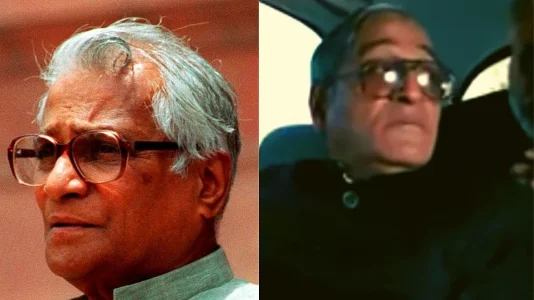
Viola! It’s time for the grand revolution inspired not by Azad, Bhagat Singh, et al but by Vladimir Lenin. At this point, the communist playbook unfolds in full unsubtle technicolour. The ground has already been prepared by portraying a BJP-ruled India as indistinguishable from the colonial British rule, which at least—sort of—redeemed itself in the form of Sue. But the BJP and Hindutva are beyond redemption and have to be overthrown, annihilated root, branch and leaf.
Rakeysh Omprakash Mehra leaves nothing to the imagination by making it explicit in a scene. India’s defence minister has to be assassinated. The losers have turned full-blooded communist revolutionaries. Except that they don’t see themselves as revolutionaries. Here’s how they see themselves in a conversation about a supposed moral dilemma over the planned murder of the defence minister.
“But we’re not murderers.”
“But they are.”
Note the collective plural, “they.”
And then we’re slowly shown Sue’s Five dramatically transforming into the modern day Bhagat Singh, Azad, Rajguru, Bismil, et al. They are not revolutionaries but freedom fighters. And they actually murder India’s defence minister as unbelievable as it is but the propaganda is nailed in.
What follows this is what we should really thank Rakeysh Omprakash Mehra for: for openly revealing one of the more sinister claws of communism. As an ideology which not only sanctions but actively encourages the revolutionary and the party member to betray and murder members of his own family, his close friends and well-wishers if they as much as doubt the ideology. Which is exactly what Karan Singhania does, by shooting his own father in cold blood whilst locked in his embrace. Remember, this is shown as an act of freedom struggle and when we recall the film’s parallel historical narrative, we get the logical picture of Bhagat Singh et al as father-murderers. Inspired by Lenin of course. Or, at any rate, freedom struggle in the realm of Rang de Basanti implies a violent rebellion against one’s own family members, which is precisely what our Incurables are doing.
Also Read
Jawaharlal Nehru University as a Tool of Communist Takeover of India: A Conversation with Dr. Shankar Saran
Ludicrous yes but highly symbolic at the same time, and rooted in a history spanning more than a century. It is unbelievable that the filmmaker who staged some really creative storytelling so far—notwithstanding the propaganda—could conceive such a weak and absurd climax. Unbelievable until you learn the grand symbolism, the great allure, and intense emotion attached to the radio station in hardcore communist circles. It was from a radio station in Moscow that the history-altering victory of the Great October Revolution was first announced to the world. Till recently, the Radio Station was a recurring wet dream of top communist porn stars of India. A little known fact is that violent communist leaders like S.A. Dange, P.C. Joshi et al had actually planned a dramatic takeover of the Bombay AIR station sometime in the early 1950s to announce that a USSR-like revolution had finally arrived in India. The announcement was to be made by an elder relative of Karan Thapar. Except that it didn’t materialize. And after all these decades, it never will. The grand revolution was a grand flop. The alternative is a cinematic fantasy consolation, fulfilled in Rang de Basanti.
There’s also a suggestion embedded in the radio station takeover scene: that the “freedom struggle” and the “martyrdom” of Sue’s Five is a harbinger of a future Hindutva apocalypse after which India will awaken to a glorious new communist dawn.
Because the fundamental premise of our communists is this: India is an illegitimate state.
Bonus footage: Throughout the movie in the scenes showing the "freedom struggle" against the then BJP Government, NDTV is shown as Propaganda Partner. And I’m only half-joking.

Viola! It’s time for the grand revolution inspired not by Azad, Bhagat Singh, et al but by Vladimir Lenin. At this point, the communist playbook unfolds in full unsubtle technicolour. The ground has already been prepared by portraying a BJP-ruled India as indistinguishable from the colonial British rule, which at least—sort of—redeemed itself in the form of Sue. But the BJP and Hindutva are beyond redemption and have to be overthrown, annihilated root, branch and leaf.
Rakeysh Omprakash Mehra leaves nothing to the imagination by making it explicit in a scene. India’s defence minister has to be assassinated. The losers have turned full-blooded communist revolutionaries. Except that they don’t see themselves as revolutionaries. Here’s how they see themselves in a conversation about a supposed moral dilemma over the planned murder of the defence minister.
“But we’re not murderers.”
“But they are.”
Note the collective plural, “they.”
And then we’re slowly shown Sue’s Five dramatically transforming into the modern day Bhagat Singh, Azad, Rajguru, Bismil, et al. They are not revolutionaries but freedom fighters. And they actually murder India’s defence minister as unbelievable as it is but the propaganda is nailed in.
What follows this is what we should really thank Rakeysh Omprakash Mehra for: for openly revealing one of the more sinister claws of communism. As an ideology which not only sanctions but actively encourages the revolutionary and the party member to betray and murder members of his own family, his close friends and well-wishers if they as much as doubt the ideology. Which is exactly what Karan Singhania does, by shooting his own father in cold blood whilst locked in his embrace. Remember, this is shown as an act of freedom struggle and when we recall the film’s parallel historical narrative, we get the logical picture of Bhagat Singh et al as father-murderers. Inspired by Lenin of course. Or, at any rate, freedom struggle in the realm of Rang de Basanti implies a violent rebellion against one’s own family members, which is precisely what our Incurables are doing.
The Emotional Allure of the Radio Station
The grand climax of this “freedom struggle” follows the father-murder. The entire sequence counts as one of the most ludicrous ventures of the filmmaker’s creativity on weed and speed. Sue’s Five takeover the HQ of All India Radio at Delhi by the force of arms—a few shoddy pistols. Then Karan launches a long-winded live broadcast drenched in the fake pathos of soft porn communist dialectic. The entire extended scene is surreal on many levels and thankfully ends with their death at the hands of the selfsame oppressive BJP-ruled India which uses overwhelming force to kill five JNU losers. Their death in this heartless manner is a double vindication of their “freedom struggle.”Also Read
Jawaharlal Nehru University as a Tool of Communist Takeover of India: A Conversation with Dr. Shankar Saran
Ludicrous yes but highly symbolic at the same time, and rooted in a history spanning more than a century. It is unbelievable that the filmmaker who staged some really creative storytelling so far—notwithstanding the propaganda—could conceive such a weak and absurd climax. Unbelievable until you learn the grand symbolism, the great allure, and intense emotion attached to the radio station in hardcore communist circles. It was from a radio station in Moscow that the history-altering victory of the Great October Revolution was first announced to the world. Till recently, the Radio Station was a recurring wet dream of top communist porn stars of India. A little known fact is that violent communist leaders like S.A. Dange, P.C. Joshi et al had actually planned a dramatic takeover of the Bombay AIR station sometime in the early 1950s to announce that a USSR-like revolution had finally arrived in India. The announcement was to be made by an elder relative of Karan Thapar. Except that it didn’t materialize. And after all these decades, it never will. The grand revolution was a grand flop. The alternative is a cinematic fantasy consolation, fulfilled in Rang de Basanti.
There’s also a suggestion embedded in the radio station takeover scene: that the “freedom struggle” and the “martyrdom” of Sue’s Five is a harbinger of a future Hindutva apocalypse after which India will awaken to a glorious new communist dawn.
Because the fundamental premise of our communists is this: India is an illegitimate state.
Bonus footage: Throughout the movie in the scenes showing the "freedom struggle" against the then BJP Government, NDTV is shown as Propaganda Partner. And I’m only half-joking.
Users who are viewing this thread
Total: 1 (members: 0, guests: 1)

Latest Replies
-
Operation Sindoor & Aftermath
- randombully
-
Indian Air Force: News & Discussions
- randombully
-
DRDO & PSUs
- randombully
-
Small Arms & Weapons
- swesh
-
Indian Culture and society
- Doreamon
-
Indian Navy Developments & Discussions
- vampyrbladez
-
Indian Special Forces
- KumaoniReborn
-
Failed Terrorist Beggar State of Pakistan: Idiotic Musings
- vin pahadi (kumauni)
-
Indian Economy
- vin pahadi (kumauni)

